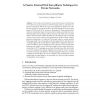Free Online Productivity Tools
i2Speak
i2Symbol
i2OCR
iTex2Img
iWeb2Print
iWeb2Shot
i2Type
iPdf2Split
iPdf2Merge
i2Bopomofo
i2Arabic
i2Style
i2Image
i2PDF
iLatex2Rtf
Sci2ools
MMMACNS
2005
Springer
2005
Springer
A Passive External Web Surveillance Technique for Private Networks
The variety and richness of what users browse on the Internet has made the communications of web-browsing hosts an attractive target for surveillance. We show that passive external surveillance of webbrowsing hosts in private networks is possible despite the anonymizing effects of NATs and HTTP proxies at the gateway. These devices effectively anonymize the origin of communication streams, and remove many identifying features, making it difficult to group web traffic into mutually disjoint same-host sets called user sessions. User sessions offer a complete picture of each user’s web browsing experience. Without them, passive external surveillance is of little use. This paper offers a content analysis technique called Link Chaining that aids the sessionization process by recovering large pieces of user sessions called session fragments. The technique is based on the knowledge that the majority of downloaded web resources are clicked-to from other web pages. By following hyperlinks i...
Computer Networks | MMMACNS 2005 | Passive External Surveillance | Session Fragments | User Sessions |
| Added | 28 Jun 2010 |
| Updated | 28 Jun 2010 |
| Type | Conference |
| Year | 2005 |
| Where | MMMACNS |
| Authors | Constantine Daicos, Scott Knight |
Comments (0)

